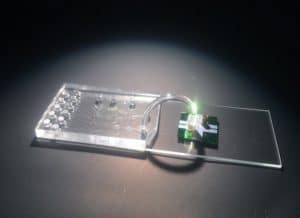
A collaboration of scientists including Professor Jean Patterson, Ph.D., of Texas Biomedical Research Institute, is working on a new way to detect Zika virus that will help guide clinicians in their treatment of patients with the disease. The test uses optofluidic chips to screen bodily fluids (blood, urine, semen) for the presence of the virus. This new approach will also help pinpoint the stage of the disease. Researchers at the University of California at Santa Cruz, Brigham Young University, and the University of California at Berkeley developed the technology being tested.
“What this technology will do is tell us, first of all, if you’ve already been infected. If you have antibodies, you wouldn’t be at risk for a new infection. It will also tell us where you are in your infection,” Dr. Patterson explained.
Knowing the stage of the disease is critical, since many antivirals only work early in infections and are not very effective later in the course of the disease. This particular diagnostic test would tell clinicians if the patient is still in the RNA replicating stage (a sign of recent infection) or if the patient has started to produce viral particles (an indication the disease has progressed).

The mosquito-borne illness was first identified in Uganda in 1947, but Zika roared into international headlines in 2014 when cases of the virus were shown to have a connection to devastating birth defects – like microcephaly – in babies born to mothers who had Zika while pregnant.
The study into a new diagnostic technology to pinpoint Zika started two years ago. Texas Biomed provides knowledge about the virus and viral material the researchers at UC Santa Cruz can test. Also, scientists are using marmosets from the Southwest National Primate Research Center to provide blood, urine and semen samples for testing. These are the kinds of samples clinicians would use for their human patients.
Dr. Patterson is confident this work will bear fruit. “We’ve got this,” she stated.
Electrical engineering Professor Holger Schmidt, Ph.D., of UC Santa Cruz describes the new technology as “a lab on a chip.” Optofluidics uses a combination of two technologies. Microfluidics is a process that takes small biological samples for detection purposes like medical and chemical analysis. Then integrated optics uses optical waveguides, lasers, and other optical elements on a chip. Together, these technologies can detect molecules without the need for amplification that other tests require.
The same test is being developed for another pathogen Texas Biomed researches: Ebola virus. Dr. Schmidt says this less complex biological assay to detect infection would be helpful for people in remote areas like parts of Africa.
The Zika optofluidics research is funded in part by a grant from the National Institutes of Health “HYBRID INTEGRATED MOLECULAR ANALYSIS (HIMAS) FOR POINT-OF-CARE DIAGNOSTICS” 5R33AI100229-05.
Other funding was made possible from generous Texas Biomed donors.
The collaboration of scientists working on the project have applied for another scientific grant and they plan to apply for a grant to commercialize the experimental Zika test.